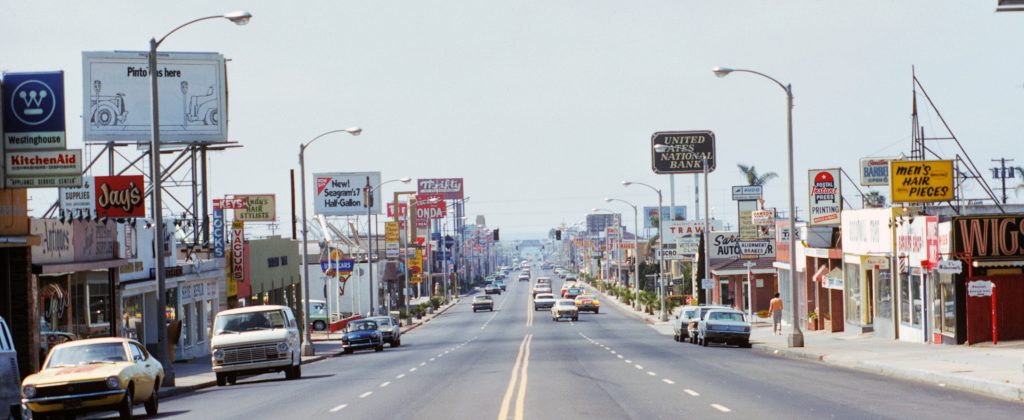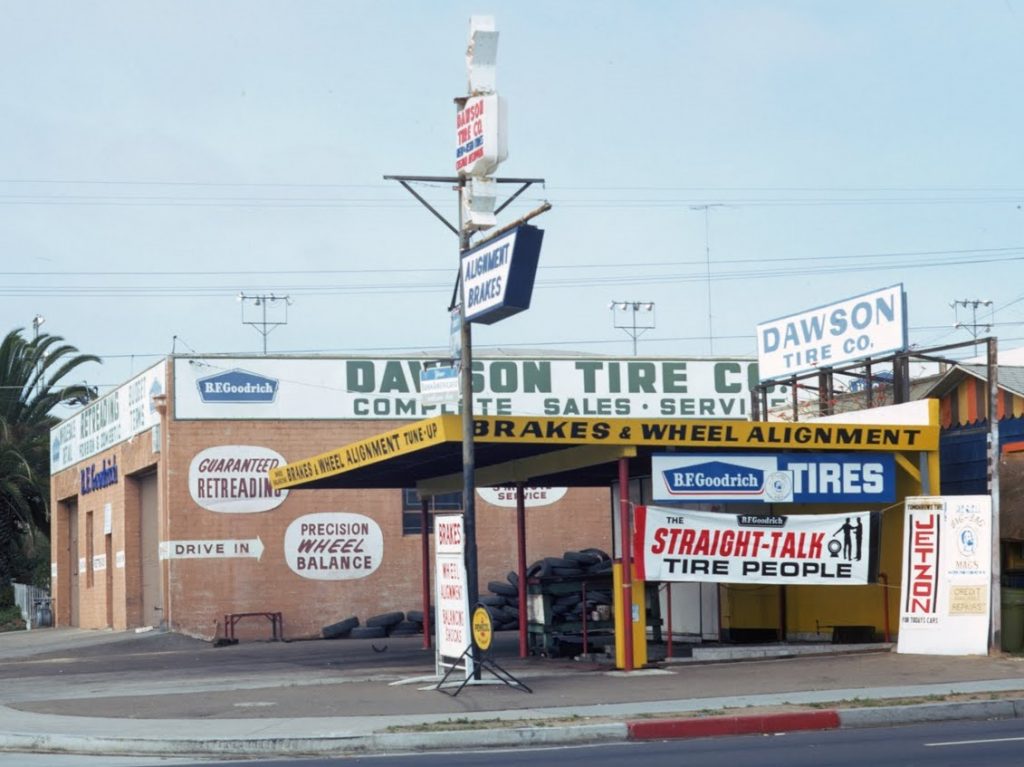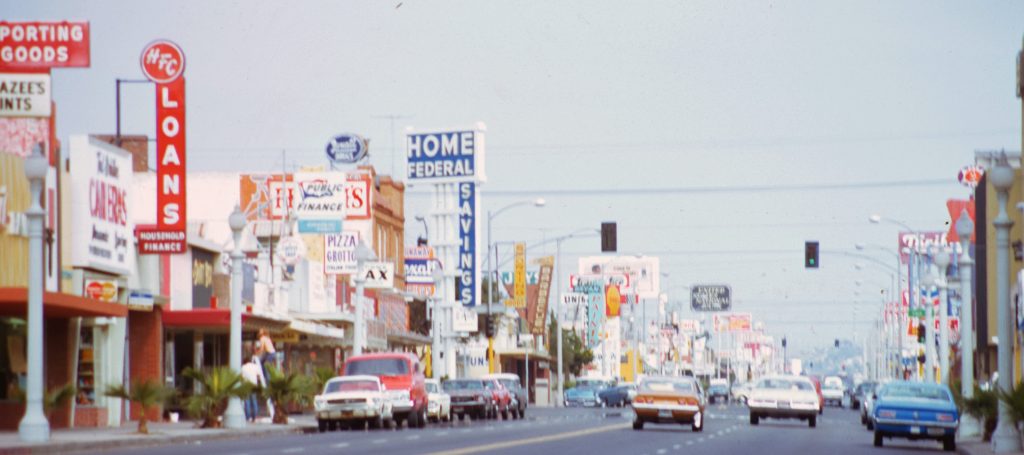
Pacific Beach grew dramatically during the twentieth century and nowhere was that growth more apparent than along Garnet Avenue, the community’s main street. Development had taken off during the war years of the 1940s and by the late 1950s Garnet was lined with commercial establishments ranging from shops, bars and gas stations to supermarkets, department stores and banks. These establishments identified themselves and advertised their businesses with signs, some painted on the sides of buildings but others mounted on roofs or projecting over sidewalks and other public property, many of them illuminated at night. The increasing number, size and brightness of signs had an increasingly negative effect on the community’s aesthetics, eventually generating resistance among residents.

The Pacific Plaza Shopping Center was built in 1960 on the former campus of Brown Military Academy on the north side of Garnet between Jewell and Lamont streets. One of the outlets in the center was a J. J. Newberry junior department store which was crowned with a large three-faced sign featuring the Newberry logo on a white background which was brilliantly illuminated at night. The store opened in February 1961 and the sign immediately provoked outrage among nearby residents. Within a month a petition signed by 173 Pacific Beach residents was submitted to the city council protesting its brilliance, which one councilman agreed was the brightest he had seen anywhere (my home at the time was a block away, facing the sign, and was among those most affected). However, the city planning director informed the council that the city had no control over signs in commercial zones. He said he would study the factors involved in the brilliance of a sign and report to the council, perhaps with a recommendation for some type of control. For its part, J. J. Newberry apparently recognized the negative public relations impact of its sign and the white background was soon turned off, leaving only the blue logo to be seen at night (which was still very large and offensive to nearby residents).

The Newberry sign was a particularly glaring example but sign pollution continued to blight Garnet Avenue and other commercial districts in San Diego for years, generating periodic complaints from citizen’s groups and occasional action by the city. After the Clairemont Town Council complained about ‘sign clutter’ and ‘visual pollution’ on a section of Morena Boulevard the San Diego City Council voted in 1971 to impose restrictions on the height and size of signs in that area. The San Diego Union noted at the time that similar zoning rules had been in effect in La Jolla for years. The Clairemont council had also called for a citywide sign ordinance and in 1973 the San Diego City Council did adopt an ordinance to regulate the number, size and other characteristics of what were called ‘on-premises signs’ in all commercial and industrial zones.
The 1973 ordinance established the legal framework for the regulation of on-premises signs. It presented a set of standards and controls designed to ‘optimize communication between the citizen and his environment’, to facilitate the ‘protection not only of the public, but the aesthetic character of the City’, and to ‘ensure the availability to the business community of adequate quality on-premises signs’. The ordinance imposed limits on the number and size of signs and required all signs to have a city permit. New or modified signs would need a building permit conforming to the new requirements; existing signs which already met the requirements could obtain a use permit. Signs that did not conform to the new requirements would be declared ‘public nuisances’ and abated ‘as prescribed by law’. Importantly, a fee based on the area of the sign would be assessed for each permit, and permits had to be renewed, and an additional fee paid, every two years.

The ordinance specified that a business having frontage on a public right-of-way of 250 feet or less would be entitled to one freestanding ground sign. The height and permitted area of ground signs would depend on the right-of-way’s width and the traffic speed allowed (although on Garnet Avenue most buildings extended all the way to their property line at the public sidewalk, leaving no space for a ground sign). Signs would be allowed on the walls of buildings visible from a public right-of-way but the permitted area of wall signs depended on the length of frontage on the right-of-way and the right-of-way’s width, and also on whether or not the premise had other ground, roof or projecting signs. Roof signs were permitted instead of, but not in addition to, ground or projecting signs if no reasonable alternative sign location existed. If permitted, roof signs would also be limited in height and area depending on the width and traffic speed of the adjoining public right-of-way. Any one premise with frontage on a public right-of-way would be permitted one projecting sign along that right-of-way instead of, but not in addition to, a ground and roof sign. The area of the projecting sign would depend on the width and traffic speed of the public right-of-way and also the frontage of the premise on that right-of-way. The maximum projection over the public right-of-way was also limited to no more than five feet or two-thirds of the width of the sidewalk, whichever was less. About 21,000 sign owners were expected to require permits for about 42,000 signs throughout San Diego.

The council passed the sign ordinance in April 1973 but it faced resistance from business owners opposed to the new regulations, and especially to the fees. According to the San Diego Union some merchants ‘lit up’ with ‘neon-like indignation’ when they learned what their fees would be and pledged to work for the recall of councilmen who voted for the sign law. For example, the Union noted that Pacific Honda at 1277 Garnet Ave. was billed $3,139 for two signs. The United Business Commission filed suit and enforcement of the ordinance was delayed for several years until an appellate court ruled that the sign fee was a ‘valid exercise of the city’s police power’ in March 1979. The city council also compromised with the business group by amending the ordinance to reduce fees for permit renewal and to allow non-conforming signs to remain until 1980.

Apparently some combination of the restrictions and fees on signs, and perhaps increased community resistance to sign pollution, have had an effect and in the decades after the 1970s the aesthetics of the city’s commercial districts have improved considerably, particularly along Garnet Avenue in Pacific Beach.
